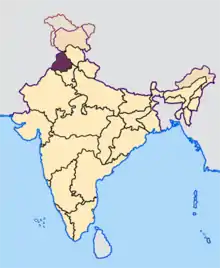Punjabi calendar
The Punjabi calendar (Punjabi: ਪੰਜਾਬੀ ਕੈਲੰਡਰ, پنجابی کیلنڈر) is a luni-solar calendar used by the Punjabi people of the Indian subcontinent, but varies by religions. Historically, the Punjabi Sikhs and Punjabi Hindus have used the Nanakshahi calendar and ancient Indian Bikrami (Vikrami) calendar respectively. Punjabi Muslims use the Arabic Hijri calendar.[1] Some festivals in Punjab, Pakistan are determined by the Punjabi calendar,[2] such as Muharram which is celebrated twice, once according to the Muslim year and again on the 10th of harh.[3] The Bikrami calendar is the one the rural (agrarian) population follows in Punjab, Pakistan.[4][note 1]
In Punjab though the solar calendar is generally followed, the lunar calendar used is purnimanta.[6] The lunar month is calculated from the ending moment of the full moon: the beginning of the dark fortnight.[7] Chaitra is considered to be the first month of the lunar year.[8] The lunar year begins on Chet Sudi: the first day after the new moon in Chet.[9] This means that the first half of the purnimanta month of Chaitra goes to the previous year, while the second half belongs to the new Lunar year.[6]
The regional new year is observed on Vaisakhi which is determined by the solar calendar.[10] The day is considered from sunrise to next sunrise and for the first day of the solar months, the Orissa rule is observed: day 1 of the month occurs on the day of the sankranti[11] (known as sangrand in Punjabi).[12]
Months (solar)
| No. | Name | Punjabi Gurmukhi | Punjabi Shahmukhi | Western months |
|---|---|---|---|---|
| 1 | Vaisakh | ਵਸਾਖ | وساکھ | Mid April – Mid May |
| 2 | Jeth | ਜੇਠ | جیٹھ | Mid May – Mid June |
| 3 | Harh | ਹਾੜ੍ਹ | ہاڑھ | Mid June – Mid July |
| 4 | Sawan | ਸਾਓਣ | ساؤݨ | Mid July – Mid August |
| 5 | Bhadó | ਭਾਦੋਂ | بھادوں | Mid August – Mid September |
| 6 | Assu | ਅੱਸੂ | اسو | Mid September – Mid October |
| 7 | Katak | ਕੱਤਕ | کتک | Mid October – Mid November |
| 8 | Maghar | ਮੱਘਰ | مگھر | Mid November – Mid December |
| 9 | Poh | ਪੋਹ | پوہ | Mid December – Mid January |
| 10 | Magh | ਮਾਘ | ماگھ | Mid January – Mid February |
| 11 | Phagun | ਫੱਗਣ | پھاگݨ | Mid February – Mid March |
| 12 | Chét | ਚੇਤ | چیت | Mid March – Mid April |
See also
Notes
- The Punjabi periodicals published in Pakistan print Punjabi calendar figures.[5]
References
- Tej Bhatia (2013). Punjabi. Routledge. p. 210. ISBN 978-1-136-89460-2.
- Pakistan Pictorial, Volume 10 (1986) Pakistan Publications
- Jacobsen, Knut A. (ed) (2008) South Asian Religions on Display: Religious Processions in South Asia and in the Diaspora. Routledge
- Mirzā, Shafqat Tanvīr (1992) Resistance Themes in Punjabi Literature. Sang-e-Meel Publications s
- Organiser, Volume 46 (1994) Bharat Prakashan
- S. Balachandra Rao (2000) Indian Astronomy: An Introduction. Universities Press
- Krishnamurthi Ramasubramanian, M. S. Sriram (2011) Tantrasaṅgraha of Nīlakaṇṭha Somayājī. Springer Science & Business Media
- Salvadori, Cynthia (1989) Through open doors: a view of Asian cultures in Kenya. Kenway Publications
- Singh, Gursharan (1996) Page 262 Punjab history conference. Punjabi University
- World Encyclopaedia of Interfaith Studies: World religions (2009) Jnanada Prakashan
- Journal of Religious Studies, Volume 34 (2003) Punjabi University
- Dilagīra, Harajindara Siṅgha (1997) The Sikh Reference Book. Sikh Educational Trust for Sikh University Centre, Denmark
